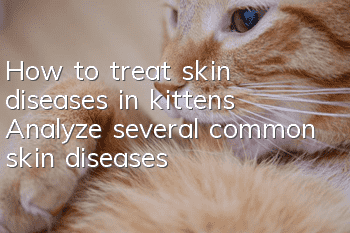How to treat skin diseases in kittens? Analyze several common skin diseases

Parents who raise cats all know that skin diseases are the most common disease in cats, because there are many kinds of skin diseases in cats, and the incidence is also different, but no matter which skin disease, Treatment is quite troublesome, so why do kittens get skin diseases? How to treat them if they accidentally get skin diseases? Let’s follow the editor of MengPet.com to find out.
1. What are the common types of skin diseases in cats?
1. Bacterial skin disease: mainly bacterial infection, relatively easy to treat
2. Fungal skin disease: caused by fungal infection of the skin; skin fungi survive for a long time in nature, have strong resistance, and can survive for more than 1 year in a dry environment. There are also some fungi that have an affinity for soil and can grow and reproduce in the soil and survive for a long time. Fungal skin diseases are the most difficult to treat and are easily transmitted to humans.
3. Ectoparasitic skin diseases: caused by fleas, scabies, demodex, ear mites, lice, ticks, etc. A single parasite can be easily eliminated, but if it is more severe and accompanied by other symptoms , treatment is more difficult.
4. Metabolic skin diseases: hormonal skin diseases and allergic skin diseases occur less frequently.
5. Immune abnormality skin diseases: Nutrition-related skin diseases, etc. Lack of nutrition can also easily cause cats to lose hair.
2. Treatment methods for cat skin diseases
Different types of skin diseases have different treatment methods. For skin diseases caused by bacteria, fungi or parasites, the treatment methods are nothing more than medicated baths, sprays, disinfection, wearing collars, sunbathing, etc.; but for nutrition For sexual skin diseases, the treatment is to strengthen nutrition, such as supplementing with B vitamins.
No matter which skin disease the symptoms are similar, and when a cat’s skin defense system goes wrong, it is easy for mixed infections to occur. The symptoms we can see may not be caused by one skin disease, but two people are infected at the same time. ~3 types of fungi are not impossible. Therefore, when a cat develops a skin disease, we must take the cat to a regular pet hospital as soon as possible to identify which skin disease the cat is suffering from so that we can quickly treat it.
If you want to correctly treat cat skin diseases, you should first identify whether the cat’s skin disease is mite type or fungal type. Therefore, parents need to take the cat to a regular pet hospital for testing to confirm the type of skin and liver disease before targeting treatment. , prescribe the right medicine. The general treatment method is to first cut off the hair in the affected area, then inject and apply topical medication. Some require periodic medicinal baths. In severe cases, infusion is required to achieve systemic anti-inflammatory purposes. At the same time, Ketocon tablets, griseofulvin tablets, etc. can be taken orally. In addition, during the medication period, it is best to supplement vitamins and feed more fatty foods, and do not feed cats milk and other alkaline foods.
3. How to prevent cat skin diseases
1. Before the rainy season comes, give the cat a bath and blow dry it.
2. All cats live in rooms facing south. They are allowed to exercise in the yard at a fixed time every day and bask in the sun. The ultraviolet rays in the sun can sterilize them.
3. The cat’s bed and litter box that cats use daily should be exposed to the sun frequently when they have time.
4. On rainy days with no sunshine, you can buy a reptile pet lamp with UV light and hang it in the cat room to shine. Look for a specially treated lamp that will not harm the animal’s eyes.
5. Frequently feed nutritional paste to increase the vitamins in their bodies and improve their immunity.
6. After the kitten is born, wash off the mucus on its body with warm water, blow it with a hair dryer until it is eighty dry, and return it to the mother cat. This method can greatly reduce the chance of the kitten getting milk moss.
4. Cat utensils should be disinfected regularly
Cat litter boxes, food utensils and bedpans should be cleaned frequently and disinfected regularly to ensure cleanliness and prevent skin diseases. All bedding materials in the cat's nest must be changed frequently, and the cat's nest should be exposed to the sun to dry. Ultraviolet rays in the sun should be used to achieve the purpose of sterilization and prevent the reproduction of microorganisms and the growth of external parasites. Environmental disinfection drugs can be used for regular disinfection. Cats' skin is relatively sensitive, so it is not advisable to use irritating disinfectants. You can use 0.1% peracetic acid spray to disinfect the cat's nest and its surrounding environment and utensils. In addition, you can use 0.1% Xinjier disinfectant to soak tableware and bedpans, or soak and wash them in 3% to 4% hot alkaline water, and then rinse them with clean water before use. Some powder drugs with low irritation and low toxicity can be taken around the cat's nest, such as chlormethrin to prevent external parasites. If the potty smells bad, use deodorizer to eliminate it.
Cat skin diseases are not only related to the environment, but also have a lot to do with the cat's own resistance. When the cat's resistance is low, it is easy to suffer from skin diseases, and it is difficult to cure. Therefore, the owner should strengthen the cat's resistance in daily life. Nutrition, add more vitamins and other trace elements to ensure the health of your cat.
- How to prevent the disease in cats with folded ears
- At what age can a cat be bathed? Cats over three months old can be bathed
- Why does the cat hiccup?
- How do new and old cats get along? How two cats get along harmoniously!
- Why did the cat vomit yellow water?
- What causes pyoderma in cats
- What will happen if a cat eats ants?
- How long will it take for Lan Bai to recognize his master?
- Can stray cats eat egg whites and yolks?
- What causes nasal branch in cats



